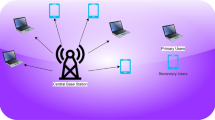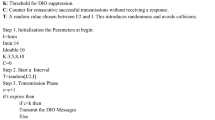Abstract
Despite that IoT technology provides a promising future for human life, some significant challenges such as routing, security, low-cost equipment, energy consumption, privacy, and reliability can considerably affect its performance. In recent studies, routing has been considered as one of the most critical challenges in IoT due to many existing IoT devices in a network. Selecting a non-optimal path increases collision probability and packet latency which sharply reduces the network performance. Hence, a novel flexible, scalable, and efficient routing protocol named LOADng-AT has been introduced in this study to overcome this challenge. Using LOADng-AT, firstly, taking advantage of the hello message, information about link quality parameters up to two hops is exchanged among nodes. This information includes various parameters such as bi-/unidirectional links, ETX, number of neighbors, link stability, received and residual energy, and SINR, gathered by hello message. Secondly, considering those parameters simultaneously, LOADng-AT efficiently chooses the best possible route based on the hybrid AHP-TOPSIS algorithm. The proposed protocol considerably decreases the RREQ broadcast storm. Moreover, it supports an error recovery path without rerunning a new routing process that noticeably decreases the network routing delay. LOADng-AT can be easily adapted to any QoS parameter with very low complexity which is very important for a delay-sensitive IoT-based network. Finally, in case of noisy condition, the proposed protocol can be efficiently used in low-quality links. Simulation results based on several scenarios in the OMNET ++ simulator show that end-to-end delay (EED) and packet delivery ratio (PDR) parameters significantly improved in the proposed method compared to other similar methods. In other words, using LOADng-AT, the mean values of PDR parameter were 98.64 and 82 percent for network sizes 400 × 200 and 800 × 400 m2, respectively, while the mean values of EED were 0.001 and 0.018 for network sizes 400 × 200 and 800 × 400 m2, respectively. The overall improvement for PDR and EED parameters in all 60 considered scenarios compared to similar methods were 82.26 and 16.6 percent, respectively.
























Similar content being viewed by others
References
Butler JG (2012) A history of information technology and systems. Univ Arizona
Suresh P, Parthasarathy C, Aswathy RH (2014) A state of the art review on the Internet of Things (IoT). Int Geol Rev 8(6):665–675. https://doi.org/10.1080/00206816609474324
Khanna A, Kaur S (2019) Evolution of Internet of Things (IoT) and its significant impact in the field of precision agriculture. Comput Electron Agric 157:218–231. https://doi.org/10.1016/j.compag.2018.12.039
Nord JH, Koohang A, Paliszkiewicz J (2019) The Internet of Things: review and theoretical framework. Expert Syst Appl 133:97–108. https://doi.org/10.1016/j.eswa.2019.05.014
Manikandan R, Patan R, Gandomi AH, Sivanesan P, Kalyanaraman H (2020) Hash polynomial two factor decision tree using IoT for smart health care scheduling. Exp Syst Appl 141:112924. https://doi.org/10.1016/j.eswa.2019.112924
El-shafeiy E, Sallam KM, Chakrabortty RK, Abohany AA (2021) A clustering based Swarm Intelligence optimization technique for the Internet of Medical Things. Exp Syst Appl 173(114648):1–6
Willis TH, Proud LA, and McClellan MS (2020) Real-time object identification and tracking network. U.S. Pat Appl 16/359
Javed F, Afzal MK, Sharif M, Kim B-S (2018) Internet of Things (IoT) operating systems support, networking technologies, applications, and challenges: a comparative review. IEEE Commun Surv Tutorials 20(3):2062–2100
Gu J, Liu C, Zhuang Y (2020) Dynamic measurement and data calibration for aerial mobile IoT. IEEE Internet Things J 7(6):5210–5219
Tawalbeh L, Muheidat F, Tawalbeh M, Quwaider M (2020) IoT privacy and security: challenges and solutions. Appl Sci 10(12):1–17. https://doi.org/10.3390/APP10124102
Sennan S, Balasubramaniyam S, and Luhach AK (2019) Energy and delay aware data aggregation in routing protocol for Internet of Things. Sensors (Switzerland), [Online]. Available: www.mdpi.com/journal/sensors
Čolaković A, Hadžialić M (2018) Internet of Things (IoT): a review of enabling technologies, challenges, and open research issues. Comput Netw 144:17–39. https://doi.org/10.1016/j.comnet.2018.07.017
Palattella MR et al (2016) Internet of Things in the 5G Era: enablers, architecture, and business models. IEEE J Sel Areas Commun 34(3):510–527. https://doi.org/10.1109/JSAC.2016.2525418
Wu Q, Ding G, Du Z, Sun Y, Jo M, Vasilakos AV (2016) A cloud-based architecture for the internet of spectrum devices over future wireless networks. IEEE Access 4:2854–2862. https://doi.org/10.1109/ACCESS.2016.2576286
Mosko M, Solis I, and Uzun E (2014) CCN 1.0 Protocol Architecture
Brogi A, Forti S (2017) QoS-aware deployment of IoT applications through the fog. IEEE Internet Things J 4(5):1–8. https://doi.org/10.1109/JIOT.2017.2701408
Huang J, Duan Q, Zhao Y, Zheng Z, Wang W (2017) Multicast routing for multimedia communications in the Internet of Things. IEEE Internet Things J 4(1):215–224. https://doi.org/10.1109/JIOT.2016.2642643
Ghaeini HR, Akbari B, and Barekatain B (2013) An adaptive packet loss recovery method for peer-to-peer video streaming over wireless mesh network. Lect Notes Electr Eng 236:713–721. https://doi.org/10.1007/978-1-4614-7010-6_80
Barekatain B, Maarof MA, Quintana AA, Ghaeini HR (2013) Performance evaluation of routing protocols in live video streaming over wireless mesh networks. J Teknol Sci Eng 62(1):85–94. https://doi.org/10.11113/jt.v62.1495
Anand V, Pandey S (2020) New approach of GA–PSO-based clustering and routing in wireless sensor networks. Int J Commun Syst 33(16):1–20. https://doi.org/10.1002/dac.4571
Farooq MU, Wang X, Hawbani A, Khan A, Ahmed A, and Wedaj FT (2020) TORP: load balanced reliable opportunistic routing for asynchronous wireless sensor networks. In: Proc. - 2020 IEEE 19th Int Conf Trust Secur Priv Comput Commun Trust. pp. 1384–1389. https://doi.org/10.1109/TrustCom50675.2020.00186
Taivalsaari A, Mikkonen T (2017) Software challenges in the IoT era. Software 1:72–80. https://doi.org/10.1109/MS.2017.26
Roldán J, Boubeta-Puig J, Luis Martínez J, Ortiz G (2020) Integrating complex event processing and machine learning: an intelligent architecture for detecting IoT security attacks. Exp Syst Appl. https://doi.org/10.1016/j.eswa.2020.113251
Paper C, Dhumane A, Technical S, and Society E (2016) Routing challenges in Internet of Things, no. March 2015, pp. 1–3
Almusaylim ZA, Alhumam A, Jhanjhi NZ (2020) Proposing a secure RPL based Internet of Things routing protocol: a review. Ad Hoc Netw. https://doi.org/10.1016/j.adhoc.2020.102096
Jaiswal K, Anand V (2020) EOMR: an energy-efficient optimal multi-path routing protocol to improve QoS in wireless sensor network for IoT applications. Wirel Pers Commun 111(4):2493–2515. https://doi.org/10.1007/s11277-019-07000-x
Sobral JVV, Rodrigues JJPC, Rabêlo RAL, Saleem K, Furtado V (2019) LOADng-IoT: an enhanced routing protocol for internet of things applications over low power networks. Sensors (Switzerland). https://doi.org/10.3390/s19010150
Jaiswal K, Anand V (2021) A Grey-Wolf based optimized clustering approach to improve QoS in wireless sensor networks for IoT applications. Peer-to-Peer Netw Appl 14(4):1943–1962. https://doi.org/10.1007/s12083-021-01099-1
Clausen T, Yi J, Herberg U (2017) Lightweight on-demand Ad hoc distance-vector routing - next generation (LOADng): protocol, extension, and applicability. Comput Netw 126:125–140. https://doi.org/10.1016/j.comnet.2017.06.025
Sobral JVV, Rodrigues JJPC, and Neto A (2018) Performance assessment of the LOADng routing protocol in smart city scenarios. 2017 IEEE 1st Summer Sch. Smart Cities, S3C 2017 - Proc., pp. 49–54. https://doi.org/10.1109/S3C.2017.8501394.
Clausen TH, and De Verdiere AC (2011) The LLN On-demand Ad hoc distance-vector routing protocol - next generation ( LOADng ), no. July, pp. 1–75
Clausen T, Yi J, and De Verdiere AC (2012) LOADng: Towards AODV version 2. IEEE Veh Technol Conf, pp. 2–6. https://doi.org/10.1109/VTCFall.2012.6399334
Barekatain B and Bin Maarof MA (2011) Network Coding Efficiency in Live Video Streaming Over Peer-to-Peer Mesh networks. In: 2011 7th Int Conf Inf Technol Asia Emerg Converg Singul Forms - Proc. CITA’11. https://doi.org/10.1109/CITA.2011.5999528
Barekatain B, Khezrimotlagh D, Maarof MA, Quintana AA, Cabrera AT (2017) GAZELLE: an enhanced random network coding based framework for efficient P2P live video streaming over hybrid WMNs. Wirel Pers Commun 95(3):2485–2505. https://doi.org/10.1007/s11277-016-3930-4
Sobral JVV, Rodrigues JJPC, Saleem K, Al-Muhtadi J (2016) Performance evaluation of LOADng routing protocol in IoT P2P and MP2P applications. 2016 Int Multidiscip Conf Comput Energy Sci Split. https://doi.org/10.1109/SpliTech.2016.7555943
Yi J, Clausen T, and Bas A (2012) Smart Route Request for on-Demand Route Discovery in Constrained Environments. In: 2012 IEEE Int Conf Wirel Inf Technol Syst ICWITS 2012, no. Lix, pp. 2–5. https://doi.org/10.1109/ICWITS.2012.6417755.
Sasidharan D, Jacob L (2018) Improving network lifetime and reliability for machine type communications based on LOADng routing protocol. Ad Hoc Netw 73:27–39. https://doi.org/10.1016/j.adhoc.2018.02.007
Sasidharan D, Jacob L (2018) A framework for the IPv6 based implementation of a reactive routing protocol in ns-3: case study using LOADng. Simul Model Pract Theory 82:32–54. https://doi.org/10.1016/j.simpat.2017.12.007
Hussain W and Merigo JM (2021) Integrated AHP-IOWA, POWA framework for ideal cloud provider selection and optimum resource management. IEEE Trans Serv Comput
Solangi YA, Longsheng C, Shah SAA (2021) Assessing and overcoming the renewable energy barriers for sustainable development in Pakistan: an integrated AHP and fuzzy TOPSIS approach. Renew Energy 173:209–222. https://doi.org/10.1016/j.renene.2021.03.141
Khatari M, Zaidan A (2021) Multidimensional benchmarking framework for AQMs of network congestion control based on AHP and Group-TOPSIS. Int J Inf Technol Decis Mak. https://doi.org/10.1142/S0219622021500127
Akram M, Kahraman C, Zahid K (2021) Extension of TOPSIS model to the decision-making under complex spherical fuzzy information. Soft Comput 25(16):10771–10795. https://doi.org/10.1007/s00500-021-05945-5
Winter ET, Thubert EP, Brandt A (2012) RPL: IPv6 routing protocol for low-power and lossy networks. RFC 6550:1–157. https://doi.org/10.17487/RFC6550
Yi J, Clausen T, and Igarashi Y (2013) Evaluation of Routing Protocol for Low Power and Lossy Networks: LOADng and RPL. In: 2013 IEEE Conf Wirel Sensor, ICWISE 2013, no. Lix, pp. 19–24. https://doi.org/10.1109/ICWISE.2013.6728773.
Yi J, Clausen T (2014) Collection tree extension of reactive routing protocol for low-power and lossy networks. Int J Distrib Sens Netw. https://doi.org/10.1155/2014/352421
Elyengui S, Bouhouchi R, and Ezzedine T (2015) A comparative performance study of the routing protocols RPL, LOADng and LOADng-CTP with bidirectional traffic for AMI scenario, pp. 43–49
A. Bas, J. Yi, and T. Clausen, “Expanding Ring Search for Route Discovery in LOADng Routing Protocol,” Proc. 1st Int. Work. Smart Technol. Energy, Inf. Commun., 2012.
Sobral JVV, Rodrigues JJPC, Kumar N, Zhu C, Ahmad RW (2017) Performance evaluation of routing metrics in the LOADng routing protocol. J Commun Softw Syst 13(2):87–95. https://doi.org/10.24138/jcomss.v13i2.376
Sobral JVV, Rodrigues JJPC, Rabêlo RL, Al-Muhtadi J (2019) Multicast improvement for LOADng in Internet of Things networks. Measurement. https://doi.org/10.1016/j.measurement.2019.106931
Marcuzzi F and Tonello AM (2019) Artificial-intelligence-based performance enhancement of the G3-PLC LOADng routing protocol for sensor networks. In: 2019 IEEE Int Symp Power Line Commun its Appl, pp. 1–6. https://doi.org/10.1109/ISPLC.2019.8693390
Djamaa B, Senouci MR, Bessas H, Dahmane B, Mellouk A (2021) Efficient and stateless P2P routing mechanisms for the Internet of Things. IEEE Internet Things J 8(14):11400–11414. https://doi.org/10.1109/JIOT.2021.3053339
Golden BL, Wasil EA, Levy DE (2016) Analytic hierarchy process application in different organisational settings. https://doi.org/10.5772/64511
Hwang CL, Lai YJ, Liu TY (1993) A new approach for multiple objective decision making. Comput Oper Res 20(8):889–899. https://doi.org/10.1016/0305-0548(93)90109-V
Brunneli M (2015) Introduction to the Analytic Hierarchy Process, 1st edn. Springer, Cham. https://doi.org/10.1007/978-3-319-12502-2
Varga A (2005) OMNeT++, discrete event simulation. Serv Des Six Sigma. https://doi.org/10.1002/0471744719.ch14
Perkins C, Belding-Royer E, and Das S (2003) Ad hoc on-demand distance vector (AODV) routing. Exp RFC. https://doi.org/10.16309/j.cnki.issn.1007-1776.2003.03.004
Zhu M, Chang L, Wang N, You I (2020) A smart collaborative routing protocol for delay sensitive applications in industrial IoT. IEEE Access. https://doi.org/10.1109/ACCESS.2019.2963723
Yi J, Clausen T, and De Verdiere AC (2012) Efficient data acquisition in sensor networks : introducing LOADng collection tree protocol, pp. 1–4
Clausen T, Yi J, Bas A, and Herberg U (2013) A depth first forwarding (DFF) extension for the LOADng routing protocol. In: Proc - 2013 1st Int Symp Comput Networking, CANDAR 2013, no. Lix, pp. 404–408. https://doi.org/10.1109/CANDAR.2013.72
Sobral JVV, Rodrigues JJPC, Rabêlo RAL, Al-Muhtadi J (2019) Multicast improvement for LOADng in Internet of Things networks. Meas J Int Meas Confed. https://doi.org/10.1016/j.measurement.2019.106931
Sobral JVV, Rodrigues JJPC, Rabelo RAL, Saleem K, Kozlov S (2003) Improving the performance of LOADng routing protocol in mobile IoT scenarios. IEEE Access. https://doi.org/10.1109/access.2019.2932718
Gonçalves AJR, Rabêlo RAL, Rodrigues JJPC, Oliveira LML (2020) A mobility solution for low power and lossy networks using the LOADng protocol. Trans Emerg Telecommun Technol. https://doi.org/10.1002/ett.3878
Khairnar M, Vaishali D, and Kotecha D (2013) Simulation-based performance evaluation of routing protocols in vehicular ad-hoc network. arXiv Prepr
Author information
Authors and Affiliations
Corresponding author
Additional information
Publisher's Note
Springer Nature remains neutral with regard to jurisdictional claims in published maps and institutional affiliations.
Rights and permissions
About this article
Cite this article
Sharifian, Z., Barekatain, B., Ariza Quintana, A. et al. LOADng-AT: a novel practical implementation of hybrid AHP-TOPSIS algorithm in reactive routing protocol for intelligent IoT-based networks. J Supercomput 78, 9521–9569 (2022). https://doi.org/10.1007/s11227-021-04256-8
Accepted:
Published:
Issue Date:
DOI: https://doi.org/10.1007/s11227-021-04256-8




